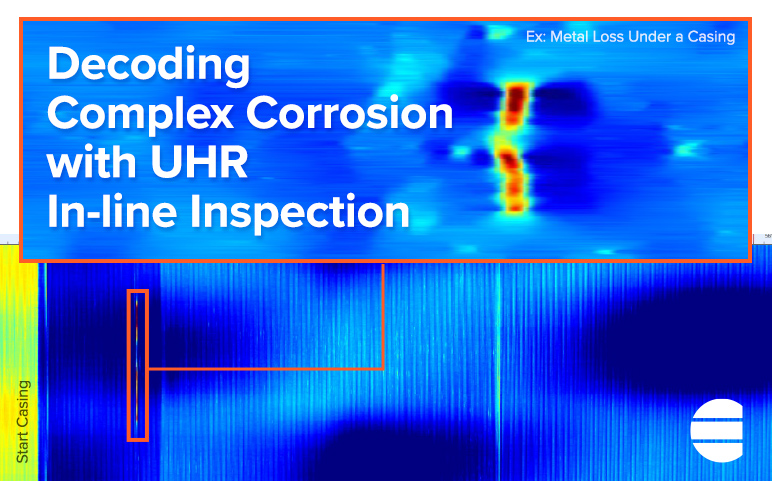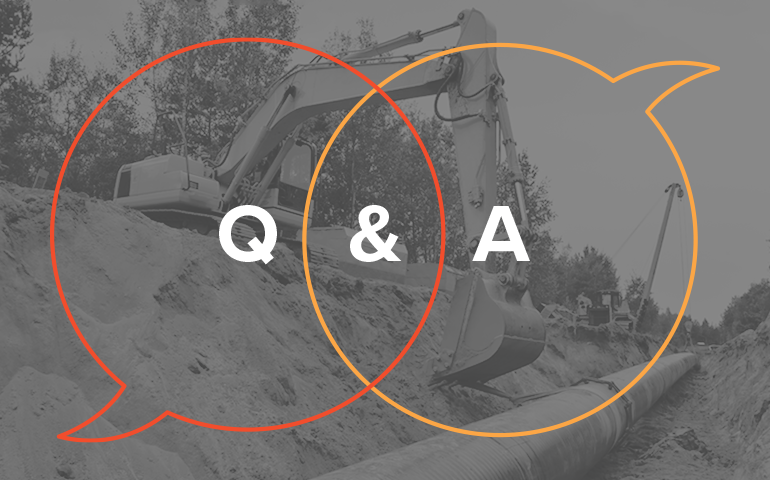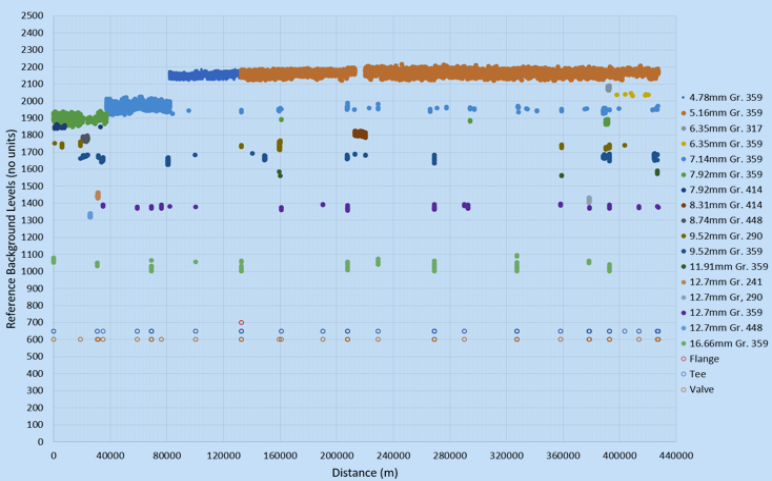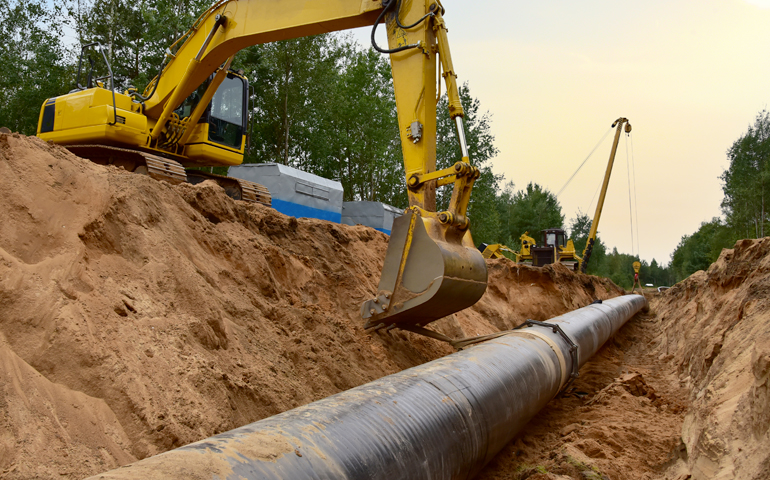
Decoding Complex Corrosion with UHR In-line Inspection
Pipeline operators know that metal loss interacting with other features is among their biggest challenges when establishing a pipeline integrity plan. Understanding the specifics of each separate anomaly is not only important, but essential. Our goal is to create a thorough understanding of complex corrosion and show how an ultra-high resolution (UHR) in-line inspection system …
Pipeline operators know that metal loss interacting with other features is among their biggest challenges when establishing a pipeline integrity plan. Understanding the specifics of each separate anomaly is not only important, but essential. Our goal is to create a thorough understanding of complex corrosion and show how an ultra-high resolution (UHR) in-line inspection system can effectively and efficiently handle these truly complex pipeline challenges.
Ultra-High Resolution ILI, along with data from historic surveys and operator input, can be used together to deliver a better, more actionable final report. This should be based on the needs of the operator and their particular pipeline challenges. The ability to tailor such a system to meet these requirements helps to tell a more complete story about complex corrosion in all its forms, from pits-in-pits to metal loss interacting with other metal loss to deformation interacting with metal loss to corrosion at or near the long seam and beyond.
The name says it all: complex corrosion. It requires a systematic solution to decode it.
The Problem: Complex Corrosion
What is complex corrosion? We look at it as any metal loss anomaly that interacts with other pipeline features as well as other metal loss or gain. These often present themselves as metal loss groups interacting with one another. As outlined in Figure 1, these take the form of metal loss associated with the following:
- Interacting with other metal loss
- Pits-in-pits
- Interacting with the Long Seam
- Interacting with a Girth Weld
- Interacting with a Deformation
- Interacting within SMLS pattern
- Interacting with Puddle Welds
- Metal loss inside a Casing (vs on the Casing)
- Interacting with a Repair Sleeve or Patch
- Interacting with a Hard Spot
- Metal loss on both the ID and OD, at the same location

The Solution: Ultra-High Resolution
Ultra-High-Resolution ILI delivers incredibly robust and nuanced data. In Figure 2 we see the quality of data such a system can provide when dealing with pits-in-pits. Such data, in the hands of an experienced DA team, results in accurate and actionable POD, POI and sizing of even the most complex corrosion.

Let’s take a closer look at how UHR ILI can meet the complex challenges posed by interacting anomalies in pipelines.
Pits-in-pits: As we said, operators tell us that pinholes within larger areas of light metal loss, or pits-in-pits, are their top integrity concern. This makes sense when you consider that most modern ILI assessment methods simply cannot see pinholes within a larger area of metal loss. Traditionally, this anomaly shown in Figure 3 would have been considered a single anomaly. With UHR MFL – true ultra-high resolution – individual features within the larger field can be identified and sized down to 3mm x 3mm and >20% deep.

Corrosion on the long seam: In Figure 4 we see a good amount of metal loss on and near a long seam. Corrosion on the long seam, by its very nature, poses an imminent integrity threat. Yet, it has traditionally been one of the most challenging to assess. Most traditional MFL technologies couldn’t even detect the long seam reliably. UHR tools provide a denser sensory array that constantly fine tunes the sampling rates of various data streams from multiple sensor types. As you can see, we can get right on top of the data with sampling frequencies that are 4x to 8x higher than other MFL tools.

Corrosion on a girth weld: In Figure 5 we can see the full capabilities of true ultra-high-resolution data in the assessment of corrosion on a girth weld. It also illustrates the difference human-based experience can make in assessing that data. On the left, the predicted versus the actual calls for this particular weld [present A and B specs]. On the right, the actual MFL data as presented to the analyst for assessment. This helps the analyst to better determine if the anomaly is interacting with the girth weld or is just adjacent it.

SMLS pipe: Assessing complex corrosion within SMLS pipe presents its own unique challenges. To a certain degree, the variables which make each SMLS pipe’s data unique are determined by variables introduced at the time the pipe was manufactured. From inconsistencies in wall thickness, to anomalies in irregular wall locations, and abrupt bore pattern changes, there are many unique factors impacting an ILI survey of SMLS Pipe. As Figure 6 shows, UHR ILI is adept at addressing them all.

Third Party damage: Differentiating mechanical damage from metal loss or metal gain is another complex challenge. In Figure 7, we see both metal loss and metal loss in a dent. UHR ILI can provide sizing even with the added complexity of corrosion within dent. That’s because UHR sensors are simply better than traditional technologies in reading these types of complex anomalies. The technology provides the data, and the analyst differentiates mechanical damage from dents to better assess the threat at hand.

Puddle welds: UHR ILI can also provide POI and POD on corrosion on or around puddle welds [Figure 8]. This helps to prevent both false positive and false negative calls – the former causing costly and unnecessary digs and the latter increasing the threat of an unintended release. Though not a common problem, metal deposition (aka puddle weld) is something that presents itself on B31.3 and B31.4 repairs. It’s also something that is more common with North American operators.

Casing corrosion: Metal loss either on the casing pipe, on the carrier pipe or both presents another set of unique challenges. Figures 9 and 10 illustrate the difference. Determining which is which is the challenge here, as the call can mean the difference between preventing an expensive repair or not. Once again, working with our operators in consultation and knowing the pipeline and its history is very helpful in arriving at an optimize solution.


Repairs: Repairs such as repair sleeves [Figure 11] and patches [Figure 12] are other areas for interaction with various types of corrosion. Assessing the integrity of a previous repair, working with the operator to look back on the pipe’s repair history and looking at potential consequences are all part of telling the story of a pipeline. And UHR ILI technology, along with the experience of the analyst, are critical elements in telling that story.


Corrosion location: In Figure 12, we see how UHR ILI can provide POD and POI of complex corrosion on the inside and outside diameters of a section of pipe. It is the perfect illustration of the benefits provided by having multiple sensor types arrayed more densely as well as having them capable of delivering a higher sampling rate. Once again, with UHR ILI, the proof is in performance.
The Proof is in Performance
Let’s take one last look at an example of UHR ILI in action.
We present a 16” ERW gas pipeline with a 0.375” wall thickness [Figure 13]. In this case, we’re again dealing with metal loss at or on the long seam. As you can see, it is preferential to the seam or engaging directly with it in some capacity. Is it on the seam? Crossing it? Is it evolving into an immediate and urgent integrity risk? UHR ILI can help the analyst – and the operator – to better answer these questions.

Conclusion
Ultra-High-Resolution ILI can bring a whole new dimension to the POD, POI and sizing of even the most complex corrosion. Such a system can help minimize risk, mitigate integrity threats and help operators prioritize – and get ahead of – their remediation programs. From the technology itself to the human-experience based data analysis and reporting behind it, UHR ILI is achieving what previously was thought next to impossible. Think of it as going beyond POD and POI to ROI in helping today’s operators to meet the moral and regulatory responsibilities they must know their pipeline. And grow their business.
The ENTEGRA Difference
Applying the latest technology and human-based insight, vision and analysis to solve real-world-problems. Putting that knowledge to work. Rinsing and repeating. That is the ENTEGRA approach to UHR in-line inspection and its application in dealing with complex corrosion. It is something that has evolved – from a technical perspective, an engineering perspective, and a people perspective – since before ENTEGRA’s founding in 2016 by the same team of engineers, operators, analysts, and field professionals who first commercialized the MFL/Combo tool more than two decades ago.




